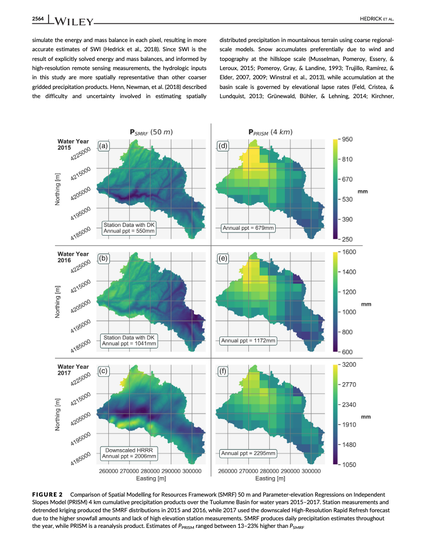
The degree to which the hydrologic water balance in a snow‐dominated headwater catchment is affected by annual climate variations is difficult to quantify, primarily due to uncertainties in measuring precipitation inputs and evapotranspiration (ET) losses. Over a recent three‐year period, the snowpack in California's Sierra Nevada fluctuated from the lightest in recorded history (2015) to historically heaviest (2017), with a relatively average year in between (2016). This large dynamic range in climatic conditions presents a unique opportunity to investigate correlations between annual water availability and runoff in a snow‐dominated catchment. Here, we estimate ET using a water balance approach where the water inputs to the system are spatially constrained using a combination of remote sensing, physically based modelling, and in‐situ observations. For all 3 years of this study, the NASA Airborne Snow Observatory (ASO) combined periodic high‐resolution snow depths from airborne Lidar with snow density estimates from an energy and mass balance model to produce spatial estimates of snow water equivalent over the Tuolumne headwater catchment at 50‐m resolution. Using observed reservoir inflow at the basin outlet and the well‐quantified snowmelt model results that benefit from periodic ASO snow depth updates, we estimate annual ET, runoff efficiency (RE), and the associated uncertainty across these three dissimilar water years. Throughout the study period, estimated annual ET magnitudes remained steady (222 mm in 2015, 151 mm in 2016, and 299 mm in 2017) relative to the large differences in basin input precipitation (547 mm in 2015, 1,060 mm in 2016, and 2,211 mm in 2017). These values compare well with independent satellite‐derived ET estimates and previously published studies in this basin. Results reveal that ET in the Tuolumne does not scale linearly with the amount of available water to the basin, and that RE primarily depends on total annual snowfall proportion of precipitation.
This document was originally published in Hydrological Processes by John Wiley & Sons, Ltd. This article has been contributed to by US Government employees and their work is in the public domain in the USA. Copyright restrictions may apply. https://doi.org/10.1002/hyp.13749.

For a complete list of authors, please see the article.